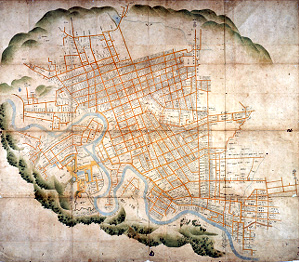Sendai
Sendai is the capital city of Miyagi Prefecture, located in the Tohoku region of Japan. It is the largest city in the Tohoku region, with a population that makes it one of the country's 20 largest cities. Sendai is often referred to as the "City of Trees" due to the many zelkova trees that line its main avenues.
History[edit | edit source]
Sendai was founded in 1600 by the daimyo Date Masamune, who built a castle in the area now known as Aoba Castle. The city's layout was designed with the principles of Chinese geomancy in mind, which contributed to its distinctive grid layout. Throughout its history, Sendai has been an important political and economic center in the Tohoku region.
Geography[edit | edit source]
Sendai is situated in the northern part of Honshu, the largest island of Japan, and is bordered by the Pacific Ocean to the east and mountains to the west. The city enjoys a temperate climate, with mild winters and warm, humid summers. The Hirose River runs through the city, adding to its scenic beauty.
Economy[edit | edit source]
The economy of Sendai is diverse, with a strong base in commerce, manufacturing, and education. The city is home to several universities, including Tohoku University, one of Japan's most prestigious institutions. Sendai's industrial sector is known for its production of electronics, appliances, and machinery. In recent years, the city has also become a hub for information technology and renewable energy.
Culture[edit | edit source]
Sendai is famous for its cultural events, most notably the Sendai Tanabata Festival, which is held every August and attracts visitors from all over Japan and beyond. The city is also known for its cuisine, including gyutan (grilled beef tongue), zunda (edamame paste), and sake produced by local breweries.
Tourism[edit | edit source]
Key attractions in Sendai include the ruins of Aoba Castle, the Zuihoden Mausoleum, which houses the remains of Date Masamune, and the Sendai City Museum. The city also serves as a gateway to the scenic regions of Matsushima Bay, one of Japan's three most scenic views, and the hot springs of nearby Sakunami.
Education[edit | edit source]
Sendai is a center of education and research, hosting several universities and research institutions. Tohoku University is renowned for its contributions to scientific research and innovation. The city's emphasis on education contributes to its vibrant cultural scene and technological advancements.
Transportation[edit | edit source]
Sendai is well-connected by road, rail, and air. The Tohoku Shinkansen connects the city to Tokyo in approximately two hours, making it accessible for business and tourism. Sendai Airport offers domestic and international flights, facilitating global connectivity.
Conclusion[edit | edit source]
Sendai combines the charm of a modern city with rich historical and cultural heritage. Its beautiful landscapes, advanced educational institutions, and vibrant festivals make it a unique destination in Japan.
Search WikiMD
Ad.Tired of being Overweight? Try W8MD's physician weight loss program.
Semaglutide (Ozempic / Wegovy and Tirzepatide (Mounjaro / Zepbound) available.
Advertise on WikiMD
|
WikiMD's Wellness Encyclopedia |
| Let Food Be Thy Medicine Medicine Thy Food - Hippocrates |
Translate this page: - East Asian
中文,
日本,
한국어,
South Asian
हिन्दी,
தமிழ்,
తెలుగు,
Urdu,
ಕನ್ನಡ,
Southeast Asian
Indonesian,
Vietnamese,
Thai,
မြန်မာဘာသာ,
বাংলা
European
español,
Deutsch,
français,
Greek,
português do Brasil,
polski,
română,
русский,
Nederlands,
norsk,
svenska,
suomi,
Italian
Middle Eastern & African
عربى,
Turkish,
Persian,
Hebrew,
Afrikaans,
isiZulu,
Kiswahili,
Other
Bulgarian,
Hungarian,
Czech,
Swedish,
മലയാളം,
मराठी,
ਪੰਜਾਬੀ,
ગુજરાતી,
Portuguese,
Ukrainian
Medical Disclaimer: WikiMD is not a substitute for professional medical advice. The information on WikiMD is provided as an information resource only, may be incorrect, outdated or misleading, and is not to be used or relied on for any diagnostic or treatment purposes. Please consult your health care provider before making any healthcare decisions or for guidance about a specific medical condition. WikiMD expressly disclaims responsibility, and shall have no liability, for any damages, loss, injury, or liability whatsoever suffered as a result of your reliance on the information contained in this site. By visiting this site you agree to the foregoing terms and conditions, which may from time to time be changed or supplemented by WikiMD. If you do not agree to the foregoing terms and conditions, you should not enter or use this site. See full disclaimer.
Credits:Most images are courtesy of Wikimedia commons, and templates, categories Wikipedia, licensed under CC BY SA or similar.
Contributors: Prab R. Tumpati, MD






